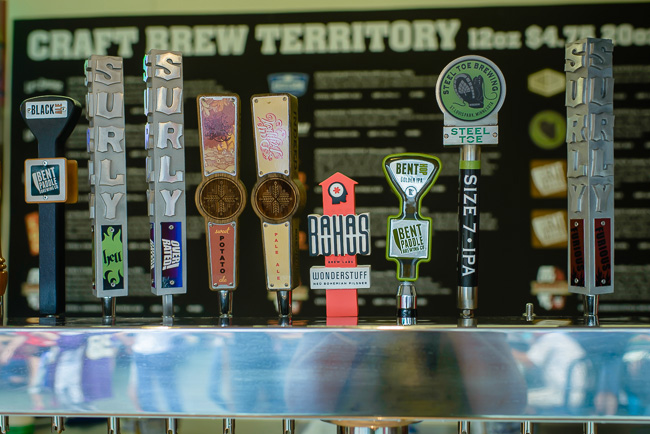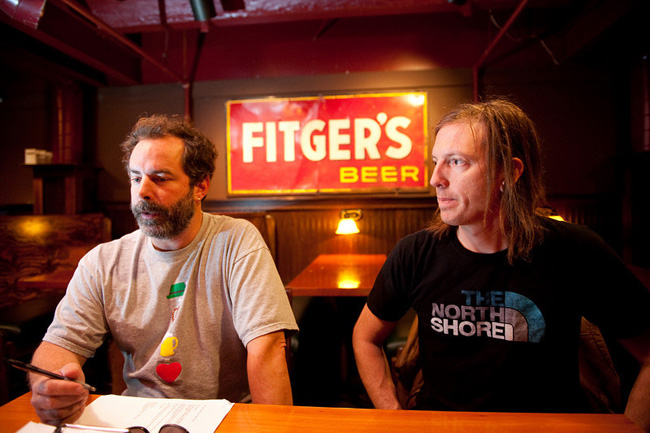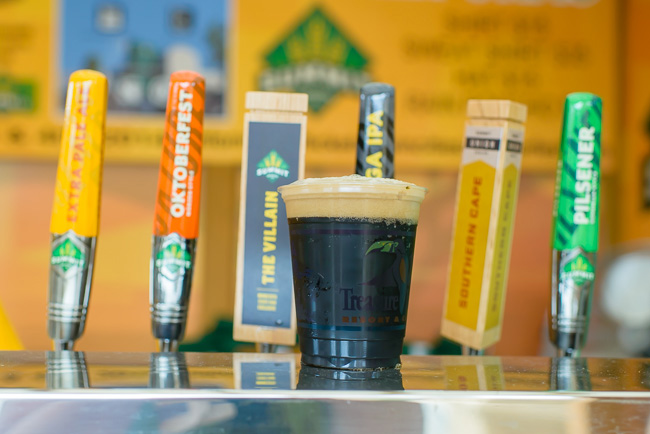
This is the third in a series of six stories underwritten by the Minnesota Craft Brewers Guild. Their financial support allows us to dig deeper into the craft, culture, and personality of Minnesota’s brewers. Read our previous installments: Part I on brewing styles, and Part II on All Pints North.
A collection of cask beers rests on a table in the foyer of the Agriculture Horticulture Building at the Minnesota State Fair. It’s right near the honey exhibit, around the corner from the apples, past the largest cabbage and the herculean pumpkins.
It’s Firkin Friday at the Land of 10,000 Beers exhibit. We’re sipping on Olvalde’s Brynhildr’s Gift, part of a 4-beer flight. It’s an already wild and wooly brew that’s driven even deeper into the woods by an infusion of juniper berries.

As we drink, we speak with Tim Nelson (above, right), founder of Fitger’s Brewhouse, about running a brewpub. “One of the biggest challenges is getting your beer to market,” says Nelson. “As a brewpub, we can only distribute to other restaurants we own; they’d be called ‘tied houses’ traditionally.” He adds that serving craft beers they produce is a way for Fitger’s to distinguish themselves in the marketplace.
Fitger’s has made obvious use of the strategy, operating multiple restaurants under their brand. But that’s more or less the only card they can play, because they’re prohibited from distributing to other bars, restaurants or retail accounts. The restriction seems like an echo of the days before the Surly Bill, when brewpubs and production breweries were organized to do separate things, either sell beer on site or distribute.
Nelson is joined on stage at the exhibit by Pete Rifakis, founder of Town Hall Brewery, another popular brewing entity that’s expanded its reach via tied houses. They’re speaking at one of the educational panels staged at the exhibit at 3pm and 6pm each day. “When we started, there were 8 or 9 craft breweries in the state of Minnesota,” says Rifakis. “I think Fitger’s preceded us by a year. The other tough part is competing with other restaurants in the area.”

But that’s not all they have to compete with. The newest business models for production breweries are blurring the lines. Urban Growler, for example, just opened with a full kitchen. Surly’s new brewery will include a pub. A production brewery can now mimic a brewpub, minus the ability to serve wine, liquor or beer they don’t make.
“The distribution laws will change,” says Rifakis. “I’m confident [of this] because other states are changing around us. Texas made the same changes we’re talking about last year, and we’ve seen Texas brewpubs come in and sell beer in our state. Breweries with the right license, from anywhere in the country or the world, can distribute here. The only breweries that can’t distribute in Minnesota, [are] Minnesota brewpub[s].”
“Deschutes [in Oregon] started as a brewpub,” Nelson adds, “and now they’re all over the state. So there is some inequity as a brewpub. But until the public starts demanding a change at a noticeable volume, it won’t happen.”
We step back to the firkin table and receive a primer on cask beer. “Now these are all kind of different, because they’re not carbonated like regular tap beer,” the attendant informs us. “They may taste kind of flat to you, but that’s because these are naturally carbonated, with different flavors added.”
 We know how cask beer works. We’ve been to Winterfest, the Beer Dabblers, and enough other events so that cask beer is second nature. But then we start to eavesdrop. Curious visitors remark that they had no idea how many breweries have popped up in the state. They’re asking for clarification about terms like citra and saison.
We know how cask beer works. We’ve been to Winterfest, the Beer Dabblers, and enough other events so that cask beer is second nature. But then we start to eavesdrop. Curious visitors remark that they had no idea how many breweries have popped up in the state. They’re asking for clarification about terms like citra and saison.
We get so wrapped up in craft beer news that we forget that not everyone is imbued with the same hysteria. Despite its surge in popularity, craft beer is still a tiny sliver of the beer market. “The overwhelming majority of people still don’t regularly drink craft beer, so there’s plenty of opportunity to welcome new consumers in,” says Clint Roberts of the Minnesota Craft Brewers Guild. “[The exhibit] is an important tool for helping us reach that broader consumer, who perhaps hasn’t taken the first step toward craft beer.”
This isn’t just marketing, it isn’t just about selling pints. It’s why the Agriculture Horticulture Building is an apt setting. It’s about education. It’s about introducing the newbie to the product and reminding the veteran that there are still issues around local beer (such as brewpub distribution and, yes, Sunday sales) that are waiting to be resolved.
